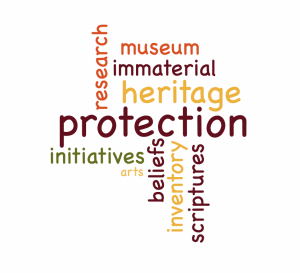3.1 increase of participants can identify 1 best practice for engaging local communities in preserving cultural heritage.
As the ‘Limitation Section above explains, it was not possible to implement a pre/ post-test evaluation at the conference. However, the qualitative responses of the participants can be analyzed to provide information on the type of knowledge gained at the meeting.
The survey assesses the ability to use knowledge through the analysis of the participants’ ability to provide a concrete example. This analysis is conducted on the measurement of two sub-indicators:
- % of participants answering the question
- Indexation of the responses in categories
64% of the participants responded to the question, “Do you have any suggestions for specific preservation programs that need to be taken for a religious community? ( please give examples)” The responses of participants were reviewed and analyzed to identify the most frequent suggestions.

The word cloud on the left shows a visual display of the word-formation; the original statements are assigned to a respective category according to frequency. It turns out that many participants in the workshop were mainly suggesting efforts towards the identification and preservation of sites. They also referred to the participation of communities and raising awareness among them to gain their support. “communities are not aware of the importance of preserving minorities’ cultures, especially in conflicted areas. To them, this is not a priority,” one respondent explains. Some participants suggested developing expertise in research, archeology, and digital skills. Several participants emphasized that it would be beneficial to enhance cooperation at key actors’ ( institutional and practitioners) level to safeguard historical sites, protect communities, and world heritage.
| Words and association | Frequency pourcentage |
| Protection | 8% |
| Identification of sites, mapping, research | 16% |
| Preservation, restoration, rehabilitation | 8% |
| Engage communities, include communities, participation of Communities | 12% |